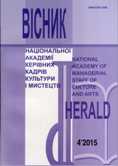КАМЕРНО-ІНСТРУМЕНТАЛЬНА ТВОРЧІСТЬ СУЧАСНИХ УКРАЇНСЬКИХ КОМПОЗИТОРІВ У ПРОЕКЦІЇ ДІАЛОГУ КУЛЬТУР
Chamber creativity of modern Ukrainian composers in the projection of the dialogue of cultures
Author(s): Anastasia Igorivna KravchenkoSubject(s): Music, Sociology, Cultural Anthropology / Ethnology, Higher Education
Published by: Національна академія керівних кадрів культури і мистецтв
Keywords: dialogue of cultures; intercultural communication; Ukrainian school of composition; chamber music;
Summary/Abstract: At the end of the 20th century the processes of art communication and intercultural dialogue activated considerably. This expedites the dynamics of Ukraine musical culture development. There are several inculturational factors that promoted the creation of all conditions for the entry of art currents of post-industrial age into post-soviet cultural space. Transitivity of Ukrainian culture at the turn of the century and existence of mental peculiarities of Ukrainian nation (that causes inclination to alternative views). For multiethnic and multireligious Ukrainian space the aspiration for the open dialogue of cultures is the basis for mutual understanding and harmonic coexistence of representatives of different ethnic minorities. The dialogue of internal multinational environment of Ukraine is deepening and widening due to the external dialogue of cultures. This is an aculturational factor which is both the process and the outcome of interchange, mutual influence of cultures at the same time, with full preservation of original authentic features and cultural identity. Existence of external contacts leads to enrichment of conception about art heritage and the import of world experience.At the turn of the 20-21 centuries Ukrainians composers broadened their information and cultural field greatly due to the participation in international creative and educational events: acquirement of the second higher in education musical academies of Europe (e.g. S. Azarova, Iu. Homelska), realization of grants for creative residences (Iu. Homel-ska, A. Zagaikevych, V. Runchak, L. Samodaieva, V. Sylvestrov, A. Tomlyonova, K. Tsepkolenko, L. Iurina), managing studios of musical courses (L. Dychko, V. Larchikov, L. Samodaieva, K. Tsepkolenko, O. Shchetynskiy, L. Iurina) and teaching in foreign universities against the contract (O. Krasotov).Knowledge and impressions, received in the dialogue of cultures, a composer, as a subject of musical culture, integrates in his/her own intellectual and creative environment. This process has its reflection in musical creativity both directly and indirectly in two general levels – idea-image and stylistic. The latter is displayed in folklore usage that is a part of the basis of professional composing creativity due to its picturesqueness, metaphoricalness, rhythms and intonations (in chamber compositions of O. Krasotov, Iu. Homelska, K. Maidenberg-Todorova). Among authentic folklore themes and auteur quasi-folklore motifs, one can findquasi-archaic motifs in the creativity of Ukrainian composers. This is caused by the interest to ancient traditions and mythology, aspiration for plunging into ancient-age perception of the world and reproducing their impressions in sound reality (S. Azarova, Iu. Homelska).Vast majority of chamber compositions and based on the idea of approaching, understanding or synthesis of cultures which are distant in spatiotemporal and mental dimensions. But there are certain compositions in which the au-thors are giving the material in the contrast of image and theme spheres in order to emphasize polarity, differences of miscellaneous cultural traditions. Thereby, the concept of the composition is based on contraposition, not convergence, often displaying East-West issues in musical art (in creativity of A. Tomlyonova, S. Azarova among others). East-West creative agenda is topical not only as a set by the author conceptual basis of composition, but also as really existent genetic roots that unconsciously "germinate" into the internal structure of a piece of music disregarding the fact whether the composer uses some authentic folk themes or ethnically-tinged rhythm and intonation quasi-folklore formulas.To sum up, it’s possible to say that a specific feature of modern cultural space of Ukraine is an integration of in-culturational and aculturational processes through deepening and widening the dialogue of cultures of internal multina-tional, multireligious environment of Ukraine by virtue of intensifying of international contacts. Internationalisation of Ukrainian artists’ thought is taking place in a free dialogue (polylogue) of cultures which is a powerful source of creativity and finds its reflection in chamber music on idea-image level (in conceptual vector of converging, contraposition, dualism of cultures) and neo-folklore stylistic level (in usage of authentic folklore, variational explanation of folklore or creation of auteur quasi-folklore, quasi-archaic themes). Taking into consideration incumbency into Ukrainian mentality and culture, openness for the dialogue of cultures (in its different planes – from interpersonal interethnic to the dialogue of cultural traditions of different epochs) is conductive to broadening of individual cultural and information field and art communication, exchange and mutual enrichment of cultures, multiplication and renewal of traditions of the Ukrainian school of composition, and, in general, integration of Ukrainian art into the world process.
Journal: Вісник Національної академії керівних кадрів культури і мистецтв
- Issue Year: 2015
- Issue No: 4
- Page Range: 69-74
- Page Count: 6
- Language: Ukrainian

